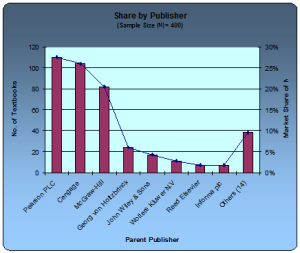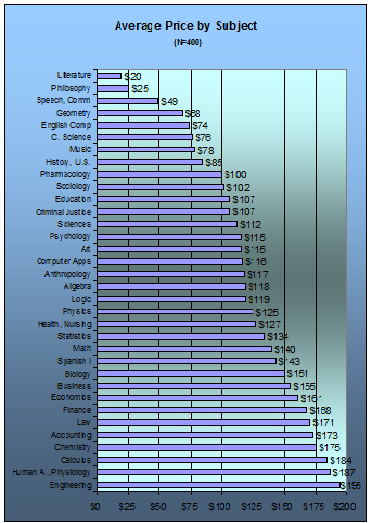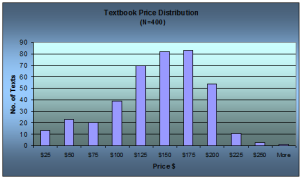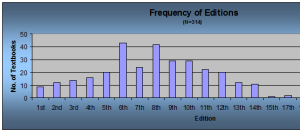 In 1915 the most expensive textbook was about $2.50 for a Geometry textbook. (See “Textbook Prices in 1915“) That is about $54 in today’s dollars. Most geometry books today are around $70, or 30% above the price index rate. More interesting, most of the textbooks in 1915 cost $1.50, which translates to $22 today. Yet, based on the sample of 400 textbooks sold between 2010 and 2012 on Amazon.com (considered one of the cheapest sources of textbooks), the average price is $133 per textbook, or a staggering 6 times above the cost-of-living index rate. Most textbooks range between $100 and $200 (80%). The primary reason that they cost so much is the ever increasing concentration of the textbook publishing industry through hundreds of acquisitions, resulting in the elimination of price competition, the established policies of schools that inhibit alternatives sources of textbooks, and somewhat the lack of awareness of professors about the cost of college textbooks they adopt for their classes. There may be others, but those are the basic reasons that allowed textbook costs to soar for the past 100 years.
In 1915 the most expensive textbook was about $2.50 for a Geometry textbook. (See “Textbook Prices in 1915“) That is about $54 in today’s dollars. Most geometry books today are around $70, or 30% above the price index rate. More interesting, most of the textbooks in 1915 cost $1.50, which translates to $22 today. Yet, based on the sample of 400 textbooks sold between 2010 and 2012 on Amazon.com (considered one of the cheapest sources of textbooks), the average price is $133 per textbook, or a staggering 6 times above the cost-of-living index rate. Most textbooks range between $100 and $200 (80%). The primary reason that they cost so much is the ever increasing concentration of the textbook publishing industry through hundreds of acquisitions, resulting in the elimination of price competition, the established policies of schools that inhibit alternatives sources of textbooks, and somewhat the lack of awareness of professors about the cost of college textbooks they adopt for their classes. There may be others, but those are the basic reasons that allowed textbook costs to soar for the past 100 years.
Based on a sample of 400 printed textbooks* sold by Amazon.com from the spring of 2010 through the spring of 2012:
- These 400 textbooks, covering 36 subjects, cost an average of $133, standard deviation is $36. The most expensive textbook was a $256 chemistry textbook. Chemistry, physics, business law, human anatomy, accounting, finance, math, economics, and calculus all had textbooks that cost more than $200.
- The subjects with the highest average cost were, in descending order, Engineering, Human Anatomy, Calculus, Chemistry, and Accounting.
- These 400 textbooks, on average, rose 4.4% from 2010 to 2012. The STEM (science, technology, engineering, and math) textbooks rose 10.2% for the same period.
- Seventy six percent of the textbooks were in their 4th to 13th edition.
- Psychology was the most popular textbook making the top 100 for all four semesters, followed by biology, business, and chemistry.
- The top three parent publishers, Pearson, Cengage, and McGraw-Hill accounted for 74% of the textbooks sold, each with over a 20% share . The other parent publishers (Georg von Holtzbrinck, John Wiley & Sons, Wolters Kluwer N.V, Reed Elsevier, Informa plc) provided 17%, and 14 other publishers, who accounted for the remaining 9%, had a 6% or less share. (As a side note, another Textbook Equity study found that gross margin on textbooks by these publishers range from 68 to 72%. There is plenty of money left over for extensive marketing and overhead salaries.)

______________________________________________
*Source of Data: Amazon.com Top 100 Textbooks Sold, Spring 2010 – Spring 2012.


